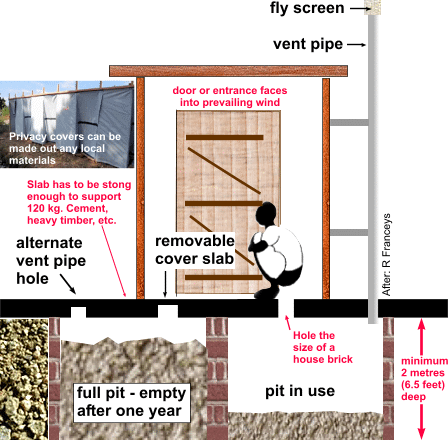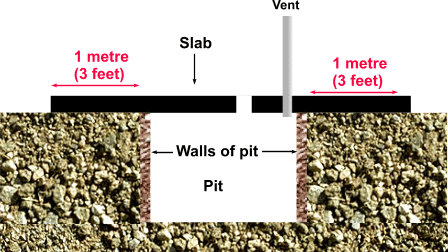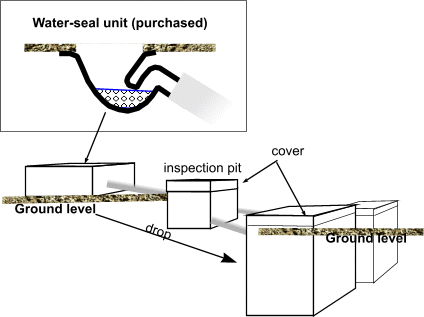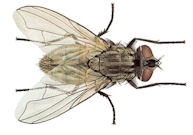
Emergency sanitation
(For the individual or for larger numbers of people in an emergency or disaster situation)
by Survival Expert James Mandeville ©2024
This article is primarily for:
General Readership, Emergency and Rescue Personnel, NGO's.
(2,186 words, Reading Level 3)
- RETURN TO ARTICLES LIST -
Emergency Sanitation
July 2024
Following a natural disaster or out in the wilderness, good hygiene and sanitation is essential to good health. Consideration must be given to both in order to stay healthy during a long–term disaster. Proper sanitation and clean water are equally necessary to combat the spread of diseases such as viral hepatitis, typhoid, cholera and dysentery.
 Yes, we are talking about dealing with poo and pee! If you are staying in an area for just a short time it is feasible to poo using a "cat hole,", which is a hole dug 15 – 30 cm (6 – 12 inches) deep. After you have relieved yourself, fill up the hole with earth and, well, that's all there is to it really. Of course, there is the problem of cleaning your bum if you don't have toilet paper, which is a high probability in a serious survival situation. The time honoured method is to use a handful of leaves. Make sure that the leaves do not contain irritants (suggest you do this before you need them!) and you can check this by rubbing a leaf sample on a small area of sensitive skin and waiting 30 minutes to see if there is any reaction. It is essential you clean the area around your rectum and your hands thoroughly every time you visit the loo. If you have soap, wash yourself for at least 20 seconds to kill off any germs and pay attention to cleaning under fingernails, the back of the hands and between the fingers. Dry using paper or a clean towel.
Yes, we are talking about dealing with poo and pee! If you are staying in an area for just a short time it is feasible to poo using a "cat hole,", which is a hole dug 15 – 30 cm (6 – 12 inches) deep. After you have relieved yourself, fill up the hole with earth and, well, that's all there is to it really. Of course, there is the problem of cleaning your bum if you don't have toilet paper, which is a high probability in a serious survival situation. The time honoured method is to use a handful of leaves. Make sure that the leaves do not contain irritants (suggest you do this before you need them!) and you can check this by rubbing a leaf sample on a small area of sensitive skin and waiting 30 minutes to see if there is any reaction. It is essential you clean the area around your rectum and your hands thoroughly every time you visit the loo. If you have soap, wash yourself for at least 20 seconds to kill off any germs and pay attention to cleaning under fingernails, the back of the hands and between the fingers. Dry using paper or a clean towel.If you do not have soap or a sanitizer containing at least 60% alcohol wash your hands in water using several changes of water. Water does not kill germs but the act of washing and drying reduces the amount of germs on the surface of the hands. Water would have to be scalding hot to kill germs so it does not really matter if the water is hot or cold. It does matter if the water itself is contaminated so using boiled water is preferable. If you are reduced to this method do not handle food or put your fingers in your mouth, rub your eyes or contact another person with the dirty areas of skin.
Bacteria in faeces have been extensively studied with an estimated 100 billion bacteria per gram of wet stool; of these, 50% of them are alive and active. The bacteria causing the greatest risk to health are E. coli, Salmonella, Shigella, and Vibrio. Salmonella can last a day on the skin, whereas Shigella can last between 2 days and 5 months. E. coli can last hours to months. Vibrio can last between one and seven days. These bacteria can also live on clothing and other surfaces with varying decay rates. Faeces from animals may also contain bacteria that can cause infections in humans. Following a disaster where large numbers of people have been displaced it is poor sanitation that leads to the spread of disease and often more people die from this than from the original disaster. Often coupled with the risk of contaminated drinking water and the spread of Cholera and Typhoid, etc. So hygiene is of paramount importance to survival. Other products you could use in an emergency are consumable alcohol, such as vodka. Lemon juice, vinegar, tea tree oil, hydrogen peroxide or glycerol are also effective. Motor car products containing antifreeze can also be of use but some people may get skin irritation from any of these and nothing beats good old soap and warm water. Urine contains fluids, salts and waste products but is sterile or free of bacteria, viruses and other disease-causing organisms unless contaminated with Escherichia coli (E. coli) from the nearby anus, this is a greater risk for women.
The dry Ventilation Improved Pit (VIP) Latrine
If you are in an area for a protracted stay or in a survival situation following a natural disaster where homes have been destroyed, there is a need for a longer–term sanitation solution. The Ventilation Improved Pit (VIP) latrine is the best option as it can be constructed quickly using local materials and does not require any chemicals or water in its use. The latrine may be a single pit or if the ground is hard to work, it may be worthwhile digging two pits. When one pit is full (to within 30 cm (12 inches) of the top), it is sealed off and the second pit is used. The pit should not be opened and emptied for one year, after which time, the waste matter is safe to handle and can be used as manure on fields, etc. Position the pit at least 15 metres (50 feet) away from living areas, wells and rivers because there will be seepage from the pit into the surrounding ground. Do not dig the pit in an area that will flood when it rains or your latrine will fill up with water. Hands must be washed thoroughly after using the latrine. An antibacterial soap is the best treatment but whatever soap is used the hands should be washed for at least 20 seconds to kill bacteria. It is practical to build hand washing facilities near the latrine, but not a washing area designed for general use (because of the smell from the latrine). Young children need to be supervised when using a pit latrine and they must be taught essential hygiene.
Double Ventilation Improved Pit (VIP) Latrine

The floor slab has to be constructed from material strong enough (obviously) to support the weight of an adult and a concrete slab is ideal. The squat–hole should not be too large, about the size of a building brick. It helps positioning to place a couple of wooden blocks as guides for the feet. A further refinement would be a grab handle or back support. If neither of these is possible, a good technique is to lower trousers or pants to below the knees and to take a firm hold of the waistband, this improves balance. The squat–hole should be covered with a stone or slab to reduce the number of insects attracted to the latrine.
A pit latrine produces methane gas and it smells; there is no way round it so good ventilation is vital. Air should be able to enter the latrine under the door, which should face into the prevailing wind and it helps if the walls do not extend fully to the ground. The vent pipe carries most of the methane gas away and it must have a fly screen fitted at the top. It is not a good idea to drop toilet paper or other paper into the pit; this should be collected and burned off. Whatever material is used for the slab, wood, concrete etc., it must be kept clean and should be washed down with soap and water. Excess water should not be allowed to enter the pit. Because decomposing excreta produces methane, no naked flame should be allowed in the area of the latrine (cigarettes, candles, hurricane lanterns, etc.) or there is a possibility (admittedly a very small one) of an explosion or fire. Do not add any chemicals to a pit latrine as this will stop the waste from naturally decomposing.
In tropical areas a latrine needs special consideration to reduce the risk of snakes or venomous insects entering. The area of ground (at least 3 metres (10 feet) around the latrine must be kept free of vegetation and the ground must be raked over each day. Snakes are less likely to travel over disturbed ground. Keep a heavy stick in the latrine in case a snake does pay you a visit — don't get caught with your pants down! It is not advisable to use the latrine in the dark. If you have to use it at night, carefully inspect the floor, walls and roof of the enclosure with an electric torch before entering. Never add any chemicals, soil or ash to a tropical pit latrine — if left alone it will attract Blow Flies, the maggots of which, will feed on the excreta and help in the process of decomposition. It is not a pleasant thing to squat over a pit that is buzzing with Blow Flies but they will not harm you; think of them as part of the waste management process.
Constructing the pit
The size of the pit depends upon the number of people using it. To calculate the size, allow for 60 litres (16 US gallons) of sludge per person per year, which equates to 0.06 cubic metres/person/year (2.12 cubic feet/person/yr.)
The pit must not cave in and if a deep pit is dug or the ground is soft, the pit walls must be supported. The best shape for the pit is circular, as this gives the strongest structure. Just the upper half of the latrine can be lined or, if necessary, it can be lined all the way down the pit. You can use all kinds of different materials to line the pit: bricks, blocks, oil drums, concrete rings, bamboo or similar basketwork and stones. Test it before anyone uses it by placing planks over the pit and jumping up and down for some minutes, then look in the pit. If any soil has fallen in then that part of the wall needs further reinforcing. If the ground is heavy clay and very solid to excavate even in wet weather, then no lining is necessary. The slab should extend 1 metre (3.3 feet) over the outer walls of the pit, so if there is subsidence, no one in the latrine will fall into the hole; see diagram below.

The wet VIP latrine
The wet VIP latrine (see diagram below) uses a water sealed unit (similar to a household toilet) that is connected to an outlet pipe, which in turn is connected to a storage pit. This latrine is flushed by pouring water into the bowl. The waste is washed down the outlet pipe, via an inspection pit, into the storage pit. Usually, two storage pits are dug, one being sealed off. When the first pit is full, it is sealed and the flow of waste is directed to the second pit. The first pit can be emptied after one year, this then becomes the latrine and the second one is sealed off and left for a year before being emptied. The advantage of this latrine, which is a more long–term sanitation solution, is that there is less smell as the water sealed unit stops methane gas from filling the latrine area so it can be located in or near a building. The storage pits must be located well away from any living area. The inspection pit also allows any blockage in the outlet pipe to be rodded clear. Because water is used to flush the latrine, the storage pits must have good drainage into the subsoil otherwise the pit rapidly fills. There is considerable pollution of the ground near the storage pits so they need careful location.
Wet VIP Latrine

In the home
If water supplies have been cut off to the home, sewerage pipes have been damaged, or the outside land is flooded, you should not flush your toilet. Instead, use two plastic bin liners, one taped inside the toilet bowl and one placed inside this bin liner. Defecate into the inner liner, remove it, check there are no leaks and gently expel the air from it, then tie the liner securely by knotting the top. Place outside in a sealed rubbish bin clearly marked as containing human excrement. Local authorities will instruct you how to deal with bags of excrement after the crisis is over.
Dealing with urine
 You should not urinate into a dry VIP latrine as this fills the pit more quickly and causes other problems with the natural decomposition of the waste. It is a good policy to make a separate urinal. Urine is not totally sterile, as many people believe; the first third of the urine flow contains many bacteria. Once the urine mixes with oxygen it will rapidly turn into a breeding ground for bacteria and it will smell. Dig a shallow pit 50 cm (20 inches) deep. Line the bottom of the pit with a layer of course gravel or pebbles and cover this with a thin layer of sand. Urinate into this hole. If the urinal starts to smell, add a layer of soil and cover this with a thin layer of sand; alternatively, add some dilute ammonia to kill off the bacteria. It is important to cover the urinal when not in use to reduce the number of flies attracted to the smell.
You should not urinate into a dry VIP latrine as this fills the pit more quickly and causes other problems with the natural decomposition of the waste. It is a good policy to make a separate urinal. Urine is not totally sterile, as many people believe; the first third of the urine flow contains many bacteria. Once the urine mixes with oxygen it will rapidly turn into a breeding ground for bacteria and it will smell. Dig a shallow pit 50 cm (20 inches) deep. Line the bottom of the pit with a layer of course gravel or pebbles and cover this with a thin layer of sand. Urinate into this hole. If the urinal starts to smell, add a layer of soil and cover this with a thin layer of sand; alternatively, add some dilute ammonia to kill off the bacteria. It is important to cover the urinal when not in use to reduce the number of flies attracted to the smell.Being prepared
Where you live in the world will be a major factor in your thinking about emergency sanitation. For example, in some countries sanitation is already very basic and with this comes knowledge handed down on how to deal with the problem. I lived for a long time in an African village where the communal latrine was a simple hole in the ground, much as described above, assisted by blow flies. Squatting over a hole to relive oneself was the norm, whereas, in a country with modern sanitation built into the infrastructure, the idea of squatting over a hole in the ground is foreign to the thinking.
Unless you are used to "primitive" sanitation, improvised methods seem uncomfortable, difficult and take some getting used to. This is especially true for elderly people and those with disabilities. In countries where buildings are connected to modern mains sewerage systems and properties have flush toilets, few people give any thought at all to what would happen if their sanitation system were to cease to function. That is a degree of preparation aforethought that very few people invest in. At the same time, people are aware of portable toilets used in mobile homes and on some campsites, but would not think of investing in a portable toilet as disaster preparation item. A little online research will reveal a large number of portable toilets are available as is a range of devices designed to allow people to urinate when on car journeys. If you are seriously thinking about future survival investing in this sort of apparatus is quite prudent. You may never need your own independent sanitation system but if that time ever came you would be very glad of it both in terms of convenience (no pun intended) and personal hygiene.
How likely are you to need your own sanitation system? Well, just look at the recent (February 2023) earthquakes in Turkey and Syria where whole apartment blocks were destroyed and many people were displaced, or in war–torn Ukraine. You have to evaluate the risk and likelihood in your own personal circumstances. In the UK, for example, most people tend not to think about preparing for disaster because our lives have been stable for a long time but if the power infrastructure failed, or we ended up in a war scenario, mains water could quickly fail and with it the possibility of flushing the toilet. Overnight the need for disposing of human waste, for soap and drinking water would become major concerns. (At least make sure you have a stock of soap and water for washing yourself also, water to drink, because without these life can rapidly take a dramatic downturn.)
